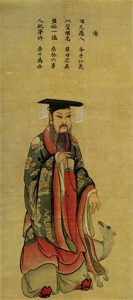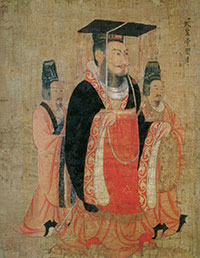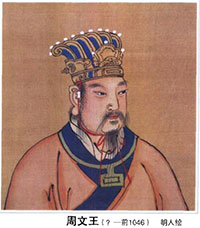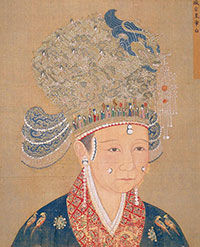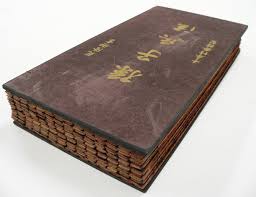 By Christie Hoerneman
By Christie Hoerneman
The 2008 Summer Olympics were held in Beijing, the capital of China. While China has been in the news recently and people are aware of some current events occurring in the county, not many realize that China has a long and complicated history full of changing dynasties. To mark the 2008 Beijing Olympics, this first article of two introduces readers to the dynasties that mark the first 2800 years of Chinese civilization.
Shang Dynasty (c.1600-1050 BC)
The Shang Dynasty, which was focused in Northern China and did not cover much of China proper, is considered one of the first true dynasties. It had a large cultural influence on the area, provides written evidence that offers a view on the world around them, and has archaeological evidence to support its existence. The Shang Dynasty consisted of city-states that had large palaces, temples, and altars surrounded by an industrial area, which was surrounded by houses. The Dynasty was ruled by kings who were important for two main reasons, their military supremacy and for religious reasons.
In Shang religion, the king had a priestly role in the worship of the high god Di and the royal ancestors. It was felt that the king could best communicate with his own royal ancestors, and the royal ancestors could communicate the best with Di. It was during the Shang Dynasty the writing was first introduced into Chinese civilization. The writing began as pictographic in nature and eventually turned into a more complex ideographic writing. Most of the writing samples from the Shang Dynasty have been lost due to being written on bamboo strips. However, some of the writing of the period does survive on bronze pieces and oracle bones.
Zhou Dynasty (1050-256 BC)
In 1050, the Zhou conquered the Shang, which vastly increased the Chinese territory. The Zhou wrote of their successful conquest as a victory of just and noble warriors over the Shang's morally degenerate ruler and courtiers. The political arrangement of city-states continued in the Zhou Dynasty. However, rather than attempting to rule all of the territories like the Shang rulers did, the Zhou rulers sent out trusted members of the family or subordinates with troops to construct walled garrisons in the territories. If it was not possible to send a trusted person the emperor knew, local chiefs were appointed as the emperor's representatives. During the Zhou Dynasty, many of the important philosophical ideas and philosophers that would define China through the centuries came into being.
Confucianism, which was founded by Confucius in the 5th and 4th centuries BC, provided moral principles for Chinese society, which emphasized both the family as a microcosm of society and filial piety within the family and the society. Confucianism also purported that the government could benefit the people by acting as a sort of "figurehead" to its family, or society. Confucius's ideas on family and society were developed and spread by his followers, especially Mencius, and continued to have a very influential role on China for almost 2,000 years. The two other major philosophies that were founded during the Zhou Dynasty were Daoism and Legalism.
Han Dynasty (206 BC-AD 220)
The Han Dynasty is marked by appointment in the administration based on merit rather than birth, military expansion, and the development of the Silk Road. It was during the Han Dynasty that the use of Confucian principles, and therefore men trained in Confucianism, became central to the government.
The Confucian principles of self-restraint, concern for others, ritual, devotion to principle, and filial piety were recognized as being important traits in government officials. The focus on Confucianism led to the wide-spread education of young men in Confucian thought. This wide-spread education became much easier with the invention of paper during the Han Dynasty. The studying of Confucianism not only helped to bring about a unity of government officials regardless of their geographic location but also in uniting China as a culture.
It was during this time that the government became more bureaucratic in nature than in previous dynasties. The Han Dynasty also increased the size of China's territory and influence to the West and the South. During the Han Dynasty, the nomadic tribes of the Steppe banded together and invaded China. This led the Han Emperor Wudi (c. 141-87 BC) to send troops to conquer the nomadic tribes and extend the Han territory in order to obtain new allies and extra supplies for the military. The expansion also led to the discovery of new areas for Chinese goods.
Sui Dynasty (581-617)/Tang Dynasty (618-907)
After the Han Dynasty, China was plunged into 400 years of political division without one group being able to gain firm control of all the territories. Finally, the Sui Dynasty (581-617) and then the Tang Dynasty were able to reunify China and strengthen its governmental structure. To further unify China, a new code of law that combined the legal traditions of the North and the South was established. During the Sui Dynasty, civil service examinations were introduced to create a large body of administrative personnel that was chosen based on merit rather than privilege or connections. The examinations focused on the Confucian classics, thus ensuring that the men appointed to civil service positions were well versed in Confucian ideology.
While many of the aristocratic families maintained their political influence by educating their children in the Confucian classics, the system allowed many talented men from unconnected families to rise in the political ranks. During the Tang Dynasty, Buddhism began to permeate Chinese life. Buddhist monks provided schools for children, lodging for travelers, and gathering places for social occasions. The monasteries also became economic powerhouses through their establishment of economic enterprises, such as mills and oil presses. These financial resources then allowed them to start money-lending and pawn-broking practices. Buddhism also provided cultural significance through the art and stories created by the monks.
Song Dynasty (960-1276)
The end of the Tang Dynasty saw the disintegration of the centralized political and military power. Local warlords, who were able to defend against rebels and bandits, took control of the local and regional areas. Then in 960 a general, Zhao Kuangyin who ruled under the name Taizu, was able to reunify China. Taizu completely overhauled the army and political system. He replaced military governors with civil officials and appointed rotating civil officials in charge of military forces to ensure that China would remain under his control. Unlike some of the earlier dynasties, the Song Dynasty, also known as the Sung Dynasty, was not able to expand its political and military influence outside of China proper. However, it was surrounded by large, powerful enemies, which resulted in improvements in military technology. In 1040, an updated military manual was commissioned, which included instructions on the building and using of broad range weapons and siege machines. The manual also included a recipe for gunpowder.
Even with all of the military advances, the Song could not hold off the Jurchens from the north, who invaded, took over the capital, and eventually the entire northern part of the Song territory. The Southern part of the Song Dynasty was able to maintain political stability until the late 13th century. Unlike the days of the Tang Dynasty, the Song Dynasty's economy was able to grow because of their stronger political stability. The Song Dynasty's economic development was due in part to the expansion of rice cultivation. Rice cultivation allowed for the population to double between 750 and 1100. The huge increase in population and the agricultural prosperity that rice cultivation helped to bring about allowed for the growth of commercialization and the economy. With the growth in economic prosperity, women's lives vastly changed, especially in the upper classes.
Upper-class women were taught to read and write, thus enabling them to write letters, write poetry, and tutor their children. In addition, women received greater legal claims to property. Orphaned daughters were given a share of the family's property to be used as their dowries, and wives' and widows' were given significant control over the dowries they brought into their marriage. Even with these advantages gained during the Song Dynasty, women had many disadvantages. The developments in Confucian ideals sought to keep women in a more restricted sphere, forcing many women to stay within the household or to completely shield themselves when out in public by wearing a veil or riding in a curtained sedan chair. Footbinding, which consisted of breaking the bones in a woman's feet when she was young in order to ensure that they did not grow to regular size, was introduced during the Song Dynasty.
Now that you have some basic information on the first six major dynasties on China, check out these resources available at the Central Rappahannock Regional Library:
Kleeman and Barrett provide a detailed and fascinating look at Ancient China beginning with Peking Man, remains found outside of Beijing which are believed to be about 500,000 years old, and ending with the Han Dynasty.
The Art of War
Even though Sunzi's (also called Sun Tsu) book on military tactics was written in the 6th century BC, it is considered a classic in military circles and is still used and studied today. It consists of thirteen chapters, each devoted to a different aspect of war.
The Cambridge Illustrated History of China
Ebrey, a professor of history at the University of Washington, has provided a great resource on Chinese history that covers all aspects of China and its culture from prehistory to the present.
The Dynasties of China
Gascoigne has written a good book that provides compact, informative histories of the major dynasties of China.
Three Chinese Poets
The translated poems of three classic Tang poets. Li Bai is also known as Li Po.
On the Web:
History Timeline
From the University of Maryland, a timeline of China with additional information for the major dynasties.
The second of these two articles on Chinese dynasties may be found here.

